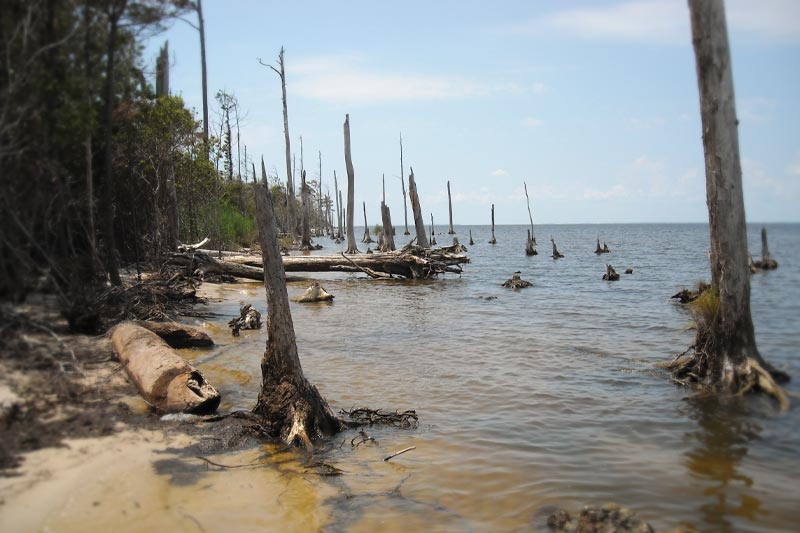
Lecture Addresses Climate Change Impact on N.C. Coastal Forests
By Gaye Hill
Lecture Addresses Climate Change Impact on N.C. Coastal Forests
By Gaye Hill
On October 27, two experts spoke at Meredith about the devastating impacts of climate change on coastal forests in North Carolina as part of the 2022 Summer Reading Program.
“Ghost forests” are a stark and visible result of rising sea levels driven by climate change because the increased saltwater poisons and kills trees that can tolerate only freshwater, leaving behind bare tree trunks in the water.
In a lecture titled “Ghost Forests: Symbols of Climate Change and Resilience,” Marcelo Ardón, associate professor for the Department of Forestry and Environmental Resources at NC State University, and Melinda Martinez, a Mendenhall Post-Doctorate/Research Ecologist with the United States Geological Survey Wetland and Aquatic Research Center, described how they have scientifically documented the spread of this phenomenon in North Carolina, how our coastal ecosystems are adapting to this change, and how we can help to slow climate change.
Martinez spoke first, sharing her journey that started as a math major at the University of Texas-Dallas and ended with her current research on coastal wetland resilience in Louisiana, having completed her Ph.D. at NC State University with Ardón as her advisor and moved on to her post-doctorate studies. She explained how she uses satellite remote sensing to measure the recovery of areas that experience disturbances such as hurricanes, droughts, saltwater intrusion, and freeze events.
“Climate change is happening now and in your state,” she said.
Martinez also shared photos of her research, including some from the Florida Everglades where she used airboats and helicopters to access remote locations.
Ardón focused on his work in the marshes of Pamlico Sound, N.C., where he studied ghost forests. He contrasted the North Carolina marshes’ poor performance in sequestering carbon with similar areas in Georgia, where marshes are more effective than forests at sequestering carbon. He noted that ditches and drains that have been used to facilitate agricultural efforts in the N.C. wetlands are also good at bringing salinity into the marsh.
“The answer to whether ghost forests are a good thing or bad thing might depend on where you are in the landscape,” he said.
Signs of Hope
Although the effects of climate change are dire in this region, positive efforts are being made to address areas that are capable of restoration. Ardón also noted a citizen science project called Sentinels of the Sounds, which invites visitors to take photos and help document ecosystem change.
He concluded his portion of the lecture by crediting his wife, Dr. Erin Lindquist, with bringing him to North Carolina and inspiring him to study trees. Lindquist was a faculty member at Meredith College from 2006-19, and this lecture was presented in her memory.
“I loved trees before I met Erin, but she really loved trees. She was a professional tree hugger,” he said.
He drew parallels between the resilience of the trees he studies and Lindquist’s fortitude as she battled cancer for seven years before passing away in 2019. He said he is happy to see that her work continues to have an impact at Meredith, citing, in particular, the Costa Rica study abroad course that Lindquist started many years ago.
Saying that although it is difficult, he feels it is his duty to keep telling her story, Ardón offered some “unsolicited advice” on her behalf, telling the students “be optimistic, be kind, be persistent, and have fun.”
When a student asked how they can help regarding climate change impacts, he encouraged them to talk about the situation.
“If you see [ghost forests] when you go out to the coast, point them out. You can help raise awareness.”
